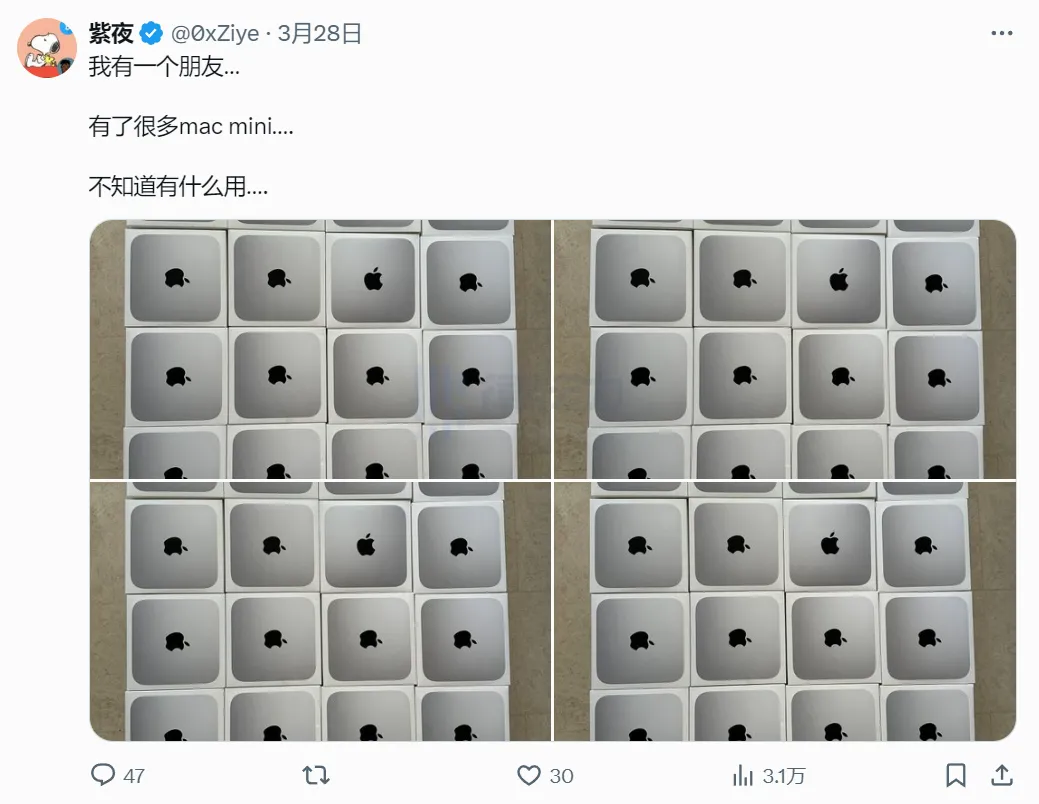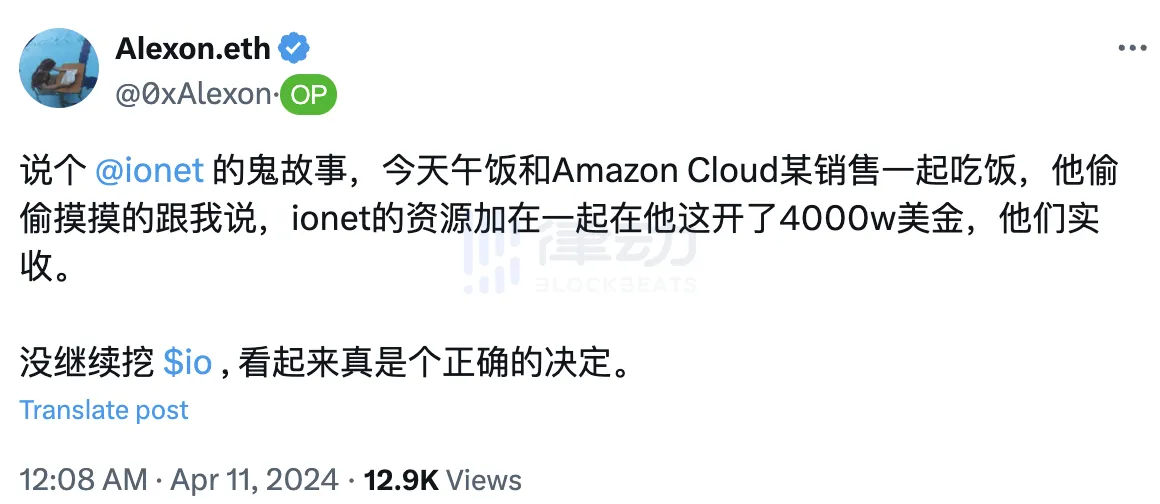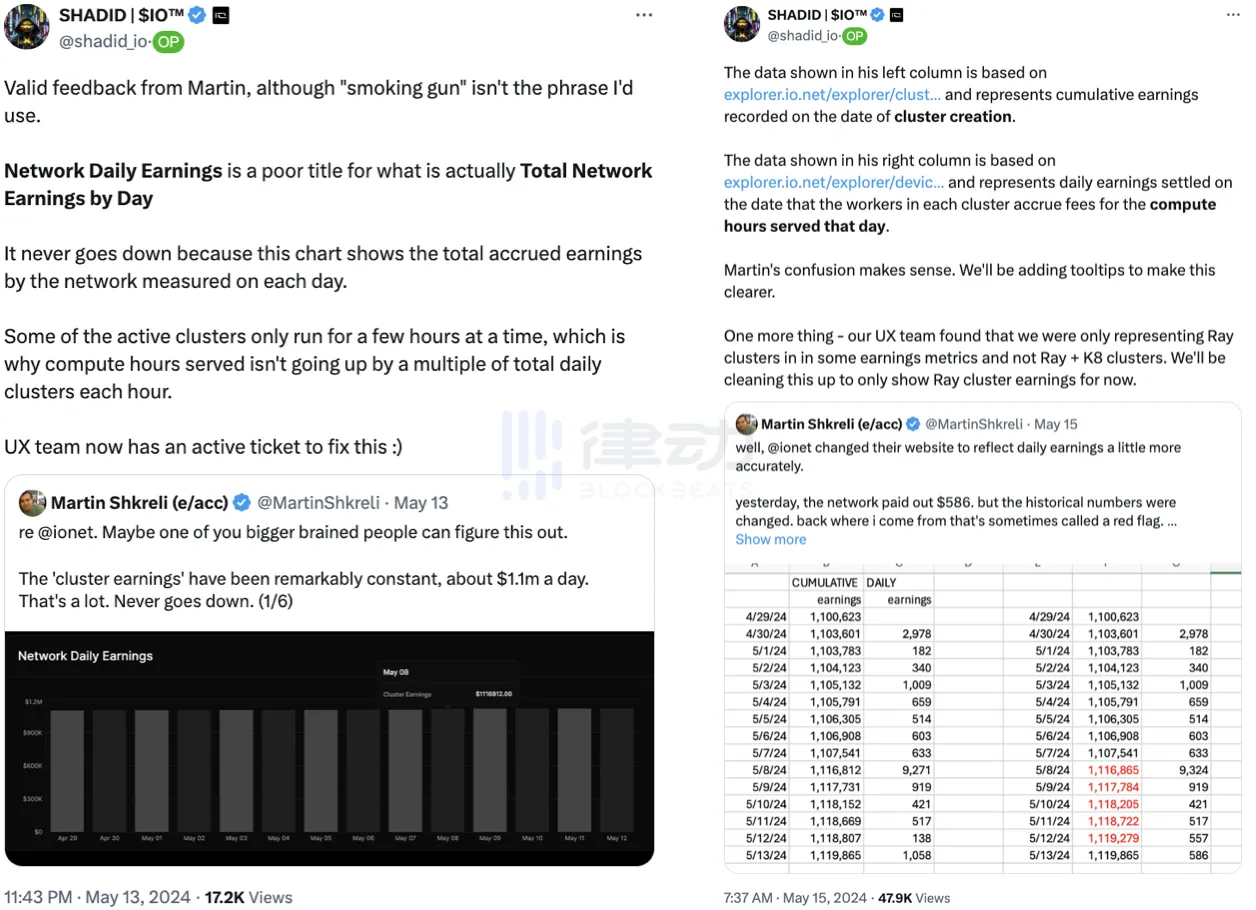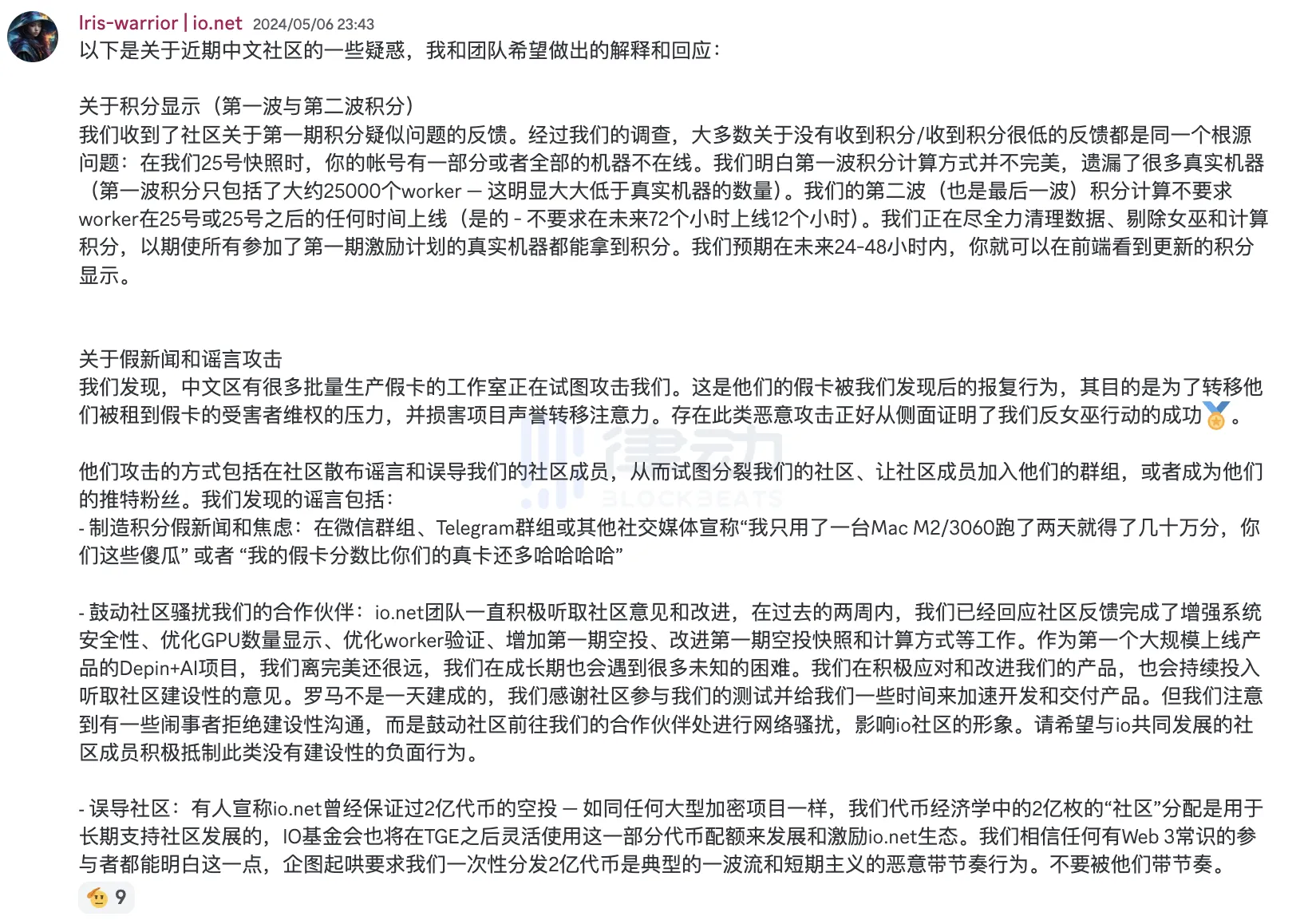Orijinal yazar: Joyce, Sky
Üç ay önce, 1 Mart'ta başlayan io.nets puan teşvik faaliyetinin ilk aşamasında, io.net kurucusu ve CEO'su Ahmad Shadid bir basın bülteni röportajında token'ın 28 Nisan'da piyasaya sürülmesinin beklendiğini söyledi. io.nets GPU arzı sonraki ayda artmış olsa da, io.net CMO'su Garrison Nisan ayı başında yaptığı bir röportajda io.net'in hala planlandığı gibi token'ları piyasaya sürdüğünü ve bunun uygun bir zaman olacak olan Nvidia'nın mali rapor yayını ile aynı zamana denk geldiğini söyledi.
Ancak 25 Nisan'da io.net ekibi telegram grubunda, ticaret platformunun io.net token'larının TGE'sinin 28 Nisan'dan sonraya ertelenmesini istediğini duyurdu. Şimdi orijinal zamandan bu yana bir ay geçti ve io.net'in token'ları yayınlaması için zaman henüz belirlenmedi. Ancak anlık görüntüden sonra, topluluk artık io.net'i umursamıyor gibi görünüyor.
Madencilik teşvik planının başlangıcından bu yana, io.net son üç ayda muazzam değişiklikler geçirdi. İlk olarak, popüler oldu ve bu boğa piyasası turunda bir yıldız proje olarak kabul edildi. Daha sonra, proje verileri dolandırıcılık nedeniyle tekrar tekrar sorgulandı ve kurucunun kara geçmişi ifşa edildi. Çok sayıda kullanıcı, io.net'i kınamak için hak koruma grupları kurdu. Token henüz piyasaya sürülmemiş olsa da, birçok kullanıcı yüksek getiri beklentilerinin boşa çıktığına inanıyor, ancak genel olarak konuşursak, io.net iyi bir projedir.
Sonuçta, herkes io.net dışında pazarın değiştiğini biliyor. On gün önce, topluluğun yüksek FDV projelerinden duyduğu memnuniyetsizlik arasında, Binance listeleme kurallarında bir revizyon duyurdu ve küçük ve orta ölçekli kripto projelerini desteklemeye başlayacağını, iyi temellere, organik topluluk temellerine, sürdürülebilir iş modellerine ve sektör sorumluluğuna sahip daha fazla küçük ve orta ölçekli projeye fırsat sağlamayı hedeflediğini, böylece blockchain ekosisteminin gelişimini teşvik edeceğini söyledi. Ve bugün, coin ihracını erteledikten bir ay sonra, io.net üçüncü madencilik faaliyetinin 1 Haziran'da başlayacağını duyurdu.
Bunaltıcı trafik
Geriye dönüp baktığımızda, iki ay önce io.net'in patlaması kaçınılmazdı. Şubat ayından bu yana AI, kripto topluluğunda tanınan servet kodu haline geldi. Nvidias hissesi yeni zirvelere ulaşmaya devam ediyor, OpenAI devrim niteliğinde yeni ürünler piyasaya sürüyor ve WLD birkaç gün içinde birkaç kat arttı. Bir dizi AI token'ının büyümesi, çoğu pist token'ını geride bıraktı.
Piyasaya girmek için tam donanımlı ve sıraya girmiş perakende yatırımcılar
Önceki hikayelerin gelişimine göre, bu turda bazı yeni AI projeleri başlatılmalı ve şanslı erken topluluk kullanıcıları yüz kat fayda sağlayacak. Tüm AI projeleri arasında eski değil yeni satın al konseptine bağlı kalarak, io.net en güvenilir görünenidir.
Genel olarak konuşursak, topluluk AI ve Web3'ün birleşim yolunu genellikle üç alt yöne ayırır: hesaplama gücü, algoritmalar ve veriler. İki ay önce, aralarında GPU kiralamanın tüm projeler arasında en popüler konumlandırma olduğu birçok yeni AI projesi ortaya çıktı. Bunun nedeni, popüler bilim düzeyinde, çoğu perakende yatırımcının AI modelleri, uygulamaları ve şifreleme teknolojisinin birleşimi açısından benzer projelerin konumlandırılmasını ve geliştirme alanını anlamakta zorluk çekmesidir. Nvidia'nın sürekli yükselişi, herkesin hesaplama gücünün gerekliliğini fark etmesini sağladı ve io.net tarafından seçilen yön, diğer projelere kıyasla kullanıcı algısında doğal bir avantaja sahip.
Özünde, ortaya çıkan tüm merkezi olmayan bilgi işlem gücü projeleri Depin kategorisine aittir ve Solana'daki Depin projesi geçen yıl sıcak bir pazar yaşadı. AI, Solana ve Depin'in birleşimi io.net'i seçilmiş bir proje haline getirdi. İyi parça seçimine ek olarak, io.net ayrıca ilk günlerde Render Network ile derinlemesine bir iş birliğine sahipti. O zamanlar, RNDR iki ayda $4'ten daha düşük bir seviyeden $13'e yükselen bir döngüdeydi.
Şubat ve Mart aylarında, sosyal medyada io.net'i tanıtan neredeyse hiç KOL yoktu. Ancak, io.net 1 Mart'ta iki aylık Ignitio.net puan ödül programını başlattığından ve token lansman tarihini doğrudan duyurduğundan beri - 28 Nisan, çok sayıda kullanıcı io.net'e akın etti. io.net'in erken dönem kullanıcılarından biri, BlockBeats'e, Discord topluluğu üyelerinin sayısının bir haftada on kat arttığına dair gözlemini anlattı.
5 Mart'ta io.net, Hack VC liderliğinde Multicoin Capital, 6th Man Ventures, Solana Ventures, OKX Ventures, Aptos Labs, Delphi Digital, The Sandbox vb. gibi diğer yatırımcılarla birlikte $30 milyonluk Seri A finansmanını tamamladığını duyurdu. Bunların arasında Multicoin Capital, Depin alanında parlak bir geçmişe sahipti ve Helium Mobile'ın (MOBILE) erken finansmanına katıldı. Ayrıca, bireysel yatırımcılar arasında Solana kurucu ortağı ve CEO'su Anatoly Yakovenko, Sandbox kurucu ortağı ve COO'su Sebastien Borget ve Animoca kurucu ortağı ve yönetim kurulu başkanı Yat Siu yer alıyor.
Güçlü VC'nin desteğiyle, io.net projesinde, merkezi olmayan bilgi işlem gücünü gerçekleştirme sürecindeki teknik zorlukların nasıl aşılacağı ve kullanıcılara ve platformlara ödeme yapmak için uygun ve yeterli bir talep tarafının olup olmadığı katılımcıların değerlendirme kapsamına girmiyor. Kullanıcı perspektifinden, inip inemeyeceğinizden korkmuyorum, sadece hikayeyi ne kadar iyi anlattığınıza bakıyorum.
io.net'in teknik katılım eşiği düşük değil. BlockBeats, etkinliğin başlangıcında, Discord'da her yerde hata geri bildirimleri olduğunu ve proje ekibinin özellikle kullanıcı tarafından gönderilen soruları almak ve ele almak için bir kanal destek bileti açtığını gözlemledi. io.net'e katılan erken dönem bir kullanıcı bir keresinde BlockBeats'e yüksek katılım eşiğinin aynı zamanda io.net konusunda iyimser olmasının nedenlerinden biri olduğunu, yani hiçbir riskin daha fazla çip ile sonuçlanmayacağı anlamına geldiğini söyledi. Ancak topluluğun beklemediği şey, çeşitli io.net madencilik eğitimlerinin daha sonra tüm İnternet'te popüler hale gelmesiydi.
io.net kullanıcısı Zhu Rui (takma ad) deneyimini BlockBeats'e ayrıntılı olarak anlattı. Zhu Rui ilk denemesinde cihazının resmi web sitesinde listelenen gereksinimleri karşılamadığını fark edince vazgeçti. Ancak daha sonra etrafındaki daha fazla insanın io.net'i incelediğini ve birçok kişinin birden fazla Mac mini'yi gösterdiğini gördü. Bir arkadaşım var... Bir sürü Mac mini'si var... Ne kullanacağımı bilmiyorum...
Belki de LuMao Studio'ya karşı önlem olarak, io.net puan ayrıntılarını yayınlamadı, yalnızca puanların makine çevrimiçi süresi, bant genişliği puanı, GPU performansı ve ekipman kiralama süresi gibi birden fazla faktörle ilişkili olacağını belirtti. Kendi ekipmanınızı katkıda bulunmanın yanı sıra, galaktik görevlere ve Discord etkinliğine katılım da çeşitli puanlar getirecek, ancak daha fazla kullanıcı kendi başlarına daha fazla ekipman satın almayı ve oyuna tamamen silahlı girmeyi tercih ediyor.
Fırsatı kaçırmak istemeyen Zhu Rui, pazara girmeyi düşünmeye başladı. Toplulukta dolaşan yapılandırma planlarını ayrıntılı olarak inceledi ve önce doğrudan bir Mac mini satın almayı düşündü. Bu strateji, az sayıda ekran kartına sahip oyuncular için uygundur, çünkü 100'den fazla ekran kartını yapılandırmak çok zahmetlidir ve bunları özel mekanlarda korumak için özel kişilere ihtiyaç vardır. Tıpkı bir madencilik fabrikası gibi, ağır bir varlıktır. Ancak avantajları da vardır. Kullandıktan sonra, ikinci el olarak yarı fiyatına satabilir veya diğer projelerde madenciliğe geçebilirsiniz. Araştırma yaparken, belki de bu yönde bir hacim eğilimi olduğunu tahmin etti. Daha önce, Pinduoduo'da bir Mac mini satın almanın fiyatı 2.100 (RMB) idi ve iki hafta sonra 2.800'e çıktı.
Mac Mini satın almanın yanı sıra, bazı kullanıcılar bulut sunucuları kiralamayı da tercih ediyor. Yurt içi ve yurt dışı olmak üzere iki farklı türde sunucu var. Yurt içi olanlar genellikle bazı bilgi işlem merkezlerinde bulunuyor, maliyeti ucuz ve kanallar mevcut. Tek bir 3080 Ti kartı yaklaşık 150 U-200 U. Yurt dışı maliyeti daha yüksek. Google Cloud'da tek bir kartın fiyatı ayda yaklaşık 1400 U ve yıllık kiralama gerektiriyor, 50'den fazla kart gerektiriyor; Tencent Cloud'da genellikle stokta olmuyor ve envanteri yok; AWS'de tek bir kartın fiyatı ayda yaklaşık 2400 U ve 8'den fazla kart gerektiriyor.
Zhu Rui sonunda premium hesap yolunu seçti. Küçük bir yabancı bulut hizmeti sağlayıcısından 200'den fazla T4 tekli kart satın aldı ve her kartı ayda 400 U'ya kiraladı. Ayrıca, 15 a1008 kartı da donattı ve her kartı ayda 1200 U'ya kiraladı. Zhu Rui bir ayda yalnızca ekipman için yaklaşık $98.000 ödemek zorunda kaldı.
Ekipman maliyetlerine ek olarak, Zhu Rui ayrıca anti-cadı tespiti için yeterli hazırlıklar yaptı. Yüzlerce IP adresi satın aldı, satın aldığı 100 Google e-posta şifresini manuel olarak değiştirdi ve tüm ekipmanı çalıştırmak için bir hafta harcadı.
Zhu Rui, io.net'in en büyük kullanıcılarından biridir. Küçük ve orta ölçekli perakende yatırımcılar, ekipmanlarıyla pazara başarılı bir şekilde girdikten sonra bile birçok zorlukla karşılaşacaklardır.
Bir io.net kullanıcısı, BlockBeats'e karmaşık yapılandırma sürecinden geçtikten sonra kullanıcıların hala bir dizi sorunla uğraşması gerektiğini hatırlattı. io.net'e bağlı cihazlar sıklıkla bağlantısı kesiliyor ve kullanıcıların cihazlarının çevrimiçi olup olmadığını anlamaları zor. Ön ucunuzun cihazın çevrimiçi olduğunu göstermesi ancak arka ucun aslında çevrimdışı olması mümkün. Bu sorunla başa çıkmak için her gün bağlantıyı otomatik olarak yeniden başlatan bir betik yazmaktan başka seçeneğimiz yok.
Çok fazla para harcamanın yanı sıra, io.net kullanıcılarının cihazlarının çalışmasını sürekli kontrol etmeleri de gerekiyor. Komut dosyası yazamayanlar için, yalnızca manuel olarak yeniden yapılandırma yapabilirler. Youtube'da 10.000'den fazla izlenen bir yapılandırma eğitiminde, airdrop blog yazarı da bu sorundan dolayı kayıptı. Bu yapılandırmaları tamamladıktan sonra cihazın çalışma durumunu resmi sayfada göremiyorsanız, tüm işlemleri tekrar yapmanızı öneririm.
Yüksek bakım maliyeti aslında io.net ayarlarındadır. Resmi açıklama, kullanıcıların tekrar tekrar yeniden yapılandırmasını istemenin amacının hangi hesapları filtrelemek olduğudur. Etkinliğin sonraki aşamalarında, bu sıklık büyük ölçüde azaltılmıştır. Bu, o zamanlar bazı kullanıcılar tarafından olumlu bir sinyal olarak da yorumlanmıştır. Sonuçta, fırtına ne kadar büyükse, balıklar da o kadar pahalıdır. Savaşta sertleşmiş Web3 oyuncuları için, sonraki aşamalardaki ödüller yeterli olduğu sürece, erken fiziksel ve zihinsel yatırım buna değer.
Bulut hizmeti sağlayıcılarının hepsi io.net'e yöneliyor
io.net'in popülaritesi, kullanıcıların yüksek bakım maliyetleriyle ilgili şikayetlerine rağmen azalmadı. İki ay önce YouTube blog yazarı "Alex'in Kripto Günlüğü" tarafından paylaşılan bir videonun başlığı, o zamanki durumu en uygun şekilde açıklayan şey olabilir: "[io.net] AI X Crypto yolunda hesaplama gücü ve şifrelemenin en güvenilir kombinasyonu. İki hafta önce, io.net'i madencilik yapmak için 600 makine kullanmayı planlamıştık, ancak bir bilgisayar odası hayalimiz iki hafta sonra paramparça oldu! Ancak bu, Gensyn'in piyasaya sürülmesinden önce aynı alandaki şüphesiz en iyi projedir."
Videoda, blog yazarı Alex, bozuk bilgisayar odası hayalinin nedenini açıkladı. Orijinal plan 800 cihaz dağıtmaktı ve tahmini kapasite tüm ağın yaklaşık 1%-2%'sine denk geliyordu. Yurt dışında bir bilgisayar odası bulduktan sonra, io.net fiyat pazarlığı sırasında popüler oldu. Daha önce iletişime geçilen tüm yurt dışı bulut hizmeti sağlayıcıları, io.net'i arayıp aramadıklarını teyit etmelerini istedi. Başlangıçta fiyatlandırma konusunda anlaşan bilgisayar odaları da tekliflerini iki katına çıkardı.
io.net viral oldu ve fiyatlarını artıran yerli ve yabancı bulut servis sağlayıcıları bu popülerlik dalgasından en çok yararlananlardan olabilir.
Şu anda, io.net'in getirdiği bu talih dalgasında bulut hizmeti sağlayıcılarının belirli kar rakamlarını hesaplamak için bir kanal yok. Alex bir zamanlar bir tweet'inde, önde gelen yabancı bulut hizmeti sağlayıcılarından Amazon Cloud'un io.net madencilik hizmetleri sağlayarak toplam 40 milyon ABD doları gelir elde ettiğini söylemişti. Yorum alanında bu sayı hakkında daha fazla şüphe olsa da, o sırada io.net ön ucunda görüntülenen yüz binlerce GPU sayısına göre hesaplanırsa, bu sayı abartılı olmayabilir.
Sadece denizaşırı bulut hizmeti sağlayıcıları faydalanmadı, BlockBeats tarafından röportaj yapılan birçok kullanıcı aynı düşünceyi dile getirdi: Tüm yerel bulut hizmeti sağlayıcıları io.net'e yöneliyor.
Bilgisayar odası kaynaklarına sahip ve perakende yatırımcı kabul etmeyen bir bulut sunucusu üreticisi olan Xiaoju (takma ad), BlockBeats'e şunları söyledi: Şimdi geriye dönüp baktığımda, io.net'ten makine kiralamak şimdiye kadar yaptığım en kolay iş. Belirli kiralama ölçeği sorulduğunda Xiaoju, Yeterli makine kaynağınız olduğu sürece, ayda milyonlarca değerinde makine kiralamak kolaydır, on milyonlarca zor değildir ve biraz çabayla yüz milyonlarca kiralanabilir. Çeşitli yurtiçi ve yurtdışı bulutlardaki tüm makineler satıldı ve Çin'deki neredeyse tüm bilgisayar odaları kiralandı. O zamanlar, piyasadaki tüm makine satıcıları fiyatı artırdı. Kiralamak veya kiralamamak size kalmıştı. Her neyse, kiralamazsanız, bir başkası yakında kiralayacaktı.
Ayrıca io.net tarafından desteklenen cihazlar arasında Apple'ın Mac mini'leri de bulunduğundan, airdrop'lardan yararlananlar Pinduoduo'dan onlarca milyar değerindeki tüm Mac mini'leri satın alarak fiyatlarını birkaç yüz yuan artırdı, Xianyu'daki Mac mini'lerin de fiyatlarını birkaç yüz yuan artırdılar.
Nisan ayında bile, io.nets teşvik kampanyasının ilk aşaması yarıya inmişken, kullanıcılar daha fazla ekipman satın almaya çalışmaya devam etti. Xiaoju, "Nisan ayından sonra makine kiralamayı bıraktım, ancak birçok kişi hala kiralamak için bana geldi. Onlara her zaman bir ay kiralamanın maliyet açısından etkili olmadığını ve kiralarlarsa temelde paralarını geri alacaklarını söyledim. Yapmayın, çok cazip." diye hatırladı.
Uyumsuz beklentiler
Kripto endüstrisindeki geçmiş hikayelere bakılırsa, io.net'e yatırım yapan kullanıcıların hepsi doğru formülü kullanmıştır. Geri ödeme riskiyle karşı karşıya kalındığında, birçok duygunun olması kaçınılmazdır. Ancak, bir Web3 projesi için, io.net projesinin kendisi çok fazla kötülük yapmamış, etkileşimli deneyimi sürekli olarak iyileştirmiş ve anlaşmazlıklara nispeten hızlı bir sürede yanıt vermiştir. Ancak çeşitli sorunlar gerçekten de meydana gelmiştir ve son üç ayda io.net sık sık utanç verici durumlarla karşı karşıya kalmıştır.
İlk puan turu duyurulduktan sonra, birçok kullanıcı makineleri anlık görüntü süresi boyunca çevrimiçi olmadığı için çok düşük puanlar aldı. Toplulukta io.net projesine karşı bazı hak koruma eylemleri görünmeye başladı. Zhu Rui, 3 Mayıs'ta Twitter'da birinin io.net Eleştiri Konferansı adlı bir alan başlattığını hatırladı. 1.000'den fazla kullanıcı herhangi bir ön ısıtma olmadan katıldı ve WeChat grubu hak koruma bilgileriyle doluydu.
Puanlar hesaplanamıyor
Açık puanlara sahip diğer projelerin aksine, io.net'in en başından itibaren bir puan paneli yayınlama niyeti yok gibi görünüyor. BlockBeats, Mart ayının başlarında io.net proje ekibine yakın bir kullanıcıya ön uçta istatistiksel puanların görüntülenmesindeki sorun hakkında soru sordu. Bunun insan gücü eksikliğinden kaynaklanabileceğini tahmin etti. Bir şans varsa, bunu onlara önereceğim.
io.net puan programının lansmanından bu yana geçen iki ayda, io.net platformunda görüntülenen GPU sayısını sorgulayan sürekli sesler duyuldu. En dikkat çekeni, 13 Mayıs'ta topluluk üyesi Martin Shkreli'nin io.net ön ucunda görüntülenen verilerin doğruluğu hakkında birkaç tweet atması ve io.net kurucusu Shadid'den kişisel bir yanıt almasıydı.
Tweet'inde, platform tarafından gösterilen gelirin gerçek durumla uyuşmadığına inanıyordu. Örneğin, platformun günlük gelirinin 1,1 milyon ABD doları olduğunu, çevrimiçi küme sayısının çok az olduğunu ve platformdaki toplam hesaplama süresinin her zaman 88 saat olarak gösterildiğini buldu. Shadid'in açıklamasını aldıktan sonra Martin Shkreli, belirli günlük gelir göstergelerinin hesaplamasını yayınladı. Shadid'in yanıtı, esas olarak istatistiksel göstergelerdeki hatalar, örneğin ortalama günlük gelir ile kümülatif gelir arasındaki fark ve gelirin diğer özelliklerin kümelerini hesaplamaması etrafında dönüyordu.
ContinueCapital'in kurucusu Pima, iki ay önce birkaç merkezi olmayan AI projesinin şu anda birbirlerinin portlarını aradığını ve hesaplama gücünü paylaştığını belirtti. io.net'in erken dönem anonim kullanıcılarından biri de BlockBeats'e io.net'teki kullanıcılar tarafından sağlanan ekipmanın Render Network'te kiralanabileceğini ve bunun tersinin de geçerli olduğunu açıkladı. Nisan ayının başlarında io.net ön ucu, çevrimiçi kullanılabilir GPU sayısının 200.000 olduğunu, Render Network'teki kullanılabilir GPU sayısının ise yaklaşık 3.700 olduğunu gösterdi.
Bu durumda, puanları net bir şekilde hesaplamak teknik yeteneğin bir testi olabilir. Yatırım kuruluşu Mint Ventures, io.net analizinde, merkezi olmayan bilgi işlem gücüne ulaşmak için çözülmesi gereken mühendislik doğrulama sorunları, paralelleştirme sorunları ve gizlilik koruma sorunları gibi sorunlar olduğunu belirtmiştir. Bunlar arasında, paralelleştirme sorunu, AI görevlerinin ayrıştırılması, cihazlar arasındaki veri iletimi ve iletişim maliyetleri gibi daha teknik engelleri içerir.
Nesnel olarak konuşursak, bazı kullanıcılar sahte kart parçalama makineleri satın aldıkları için cadılar tarafından gerçekten kandırılmıştı. Xiaoju, BlockBeats'e şunları söyledi: O zamanlar, kiralama pazarı çok kaotikti. Teoride, pazarda makine kaynakları kıtlığı vardı, ancak istediğiniz kadarını size verecek birçok makine satıcısı vardı. Bu aslında size gerçek makinelermiş gibi sanal makineler satmaktı. Örneğin, sınırsız kartları sanallaştırmak için bir 4090 kullanabilirlerdi ve tüccarlar sıfır maliyetle para kazanabilirlerdi. Bu tür makineler kolayca tespit edilebilirdi ve cadılar tarafından parçalanmazdı.
Ağ genelindeki haçlı seferine yanıt olarak io.net ekibi Discord'da uzun bir makale yayınladı. Cadıları ortadan kaldırmak ve gerçek kullanıcıları elde tutmak için ikinci bir puan hesaplama turu gerçekleştireceklerini söylediler. Puan anlaşmazlığına ek olarak ekip ayrıca topluluğun sahte haber ve söylenti saldırılarıyla karşı karşıya olduğunu ve bunun arkasında sahte kart stüdyosunun olduğunu belirtti.
Sahte kartların neden olduğu veri kirliliğiyle ilgili olarak, farklı io.net kullanıcıları BlockBeats'e yanıt verdi ve bunun uzun zamandır var olduğunu söyledi. io.net puanları duyurmadan iki ay önce, bir grup insanın çok sayıda sahte kart ürettiğini biliyordum. Bunu bildirmek için DC'ye gittim, ancak kimse bana dikkat etmedi. Ayrıca, diğer kişilerin de bu sorunu bildirdiğini sık sık gördüm, ancak yetkililerin dikkatini çekmedi. Xiaoju, BlockBeats'e, puanları hesaplamaya başlayana kadar sahte makineleri tespit etmeye başlayacaklarını söylemediler, ancak çok geçti, dedi.
ImbaTrader ayrıca, İlk günlerde Discord'da yalnızca birkaç bin kişi olduğunu hatırlattı. O zamanlar, Amerika Birleşik Devletleri'ndeki belirli bir üniversiteden öğrenci olduğunu iddia eden biri, io.net ön ucunda görüntülenen GPU cihazlarının sayısının sahte olup olmadığını sorguladı, ancak kimse bu konuya yanıt vermedi.
Öte yandan, belirsiz noktalar io.net proje ekibinin çip dağıtımını duruma göre ayarlaması için yeterli alan bırakıyor. io.net ile ilgili konular için çok fazla anahtar kelime haline geldiğinde, topluluk üyeleri genellikle büyük hesapların son puan miktarında düşük güvenlik aldığı durumunu yansıttılar. Küçük hesaplar (bir veya iki makine), bir düzineden fazla üst düzey grafik kartına sahip büyük hesaplarımdan daha fazla puana sahip. Gözlemlediğim kadarıyla, io.net projesinin küçük hesapları genellikle daha yüksek puanlara sahipken, daha fazla ekipmana sahip büyük hesapların puanları daha düşük. Büyük hesapları öldürüp perakende hesapları destekliyorlar gibi görünüyor. İkinci puan güncellemesinden sonra, bazı kullanıcılar puanlarının üç katına çıktığını gördü.
Ancak puanlar nasıl dağıtılırsa dağıtılsın, madencilere dağıtılan toplam token miktarı 32 milyon token olarak değişmeden kalıyor. Bu madencilik ekipmanları arasında io.net projesinin büyük bir payı olduğu görülüyor.
Mart ayının başlarında bir kullanıcı BlockBeats'e, oradaki A 100'lerin çoğunun proje makineleri olabileceğini söyledi. Ancak, cihaz kayıtlarının zincirde olmadığını düşünürsek, topluluk ayrıca io.net'in ön uç verilerini tahrif etmiş olma olasılığını da sorguladı.
Nisan ayında yayınlanan bir videoda, YouTube blog yazarı Alex Encrypted Diary, io.net ön ucundaki GPU cihazlarının sayısının 60.000 ile 80.000 arasında olduğunu, ancak bir gecede aniden 140.000 ila 150.000'e çıktığını söyledi. Ön uçta görüntülenen GPU cihazlarının sayısının her yarım saatte binlerce arttığını ve daha önce orada olmayan 4070'lerin sayısının aniden 20.000'den fazla arttığını buldu. Gerçek kullanıcılara ait cihazların çevrimiçi durumunun sabit olmadığını düşünürsek, doğrusal büyüme rakamlarının proje tarafından kaynaklandığından şüphelenmemek zor.
Birkaç gün önce, io.net'in Asya'daki başkanı Asa bir alana katıldı. Topluluk kullanıcıları tarafından dile getirilen ön uç ve arka uç verilerinin tutarsızlığı ve cihaz veri kayıtlarının merkezileştirilmesine yanıt olarak Asa, Merkezi olmayan teknoloji yığını gelecekte uygulanacak bir iyileştirmedir dedi. Teknik ekibimizin geçen ayki iş yükü, son üç aydakiyle aynıdır.
Sıkı cadı karşıtı önlemlerin üç özelliği, sahte kart kimliğinin gecikmeli lansmanı ve opak puanlar, düzgün bir şekilde etkileşim kurmak isteyen gerçek kullanıcıların katılım maliyetini görünmez bir şekilde artırdı. Trafik ve elektrik gibi ekonomik maliyetlere ek olarak, yalnızca uzun süre tutunmanıza neden olmakla kalmıyor, aynı zamanda size gerçek puanları da söylemiyor, bu nedenle herkes çok fazla enerji ödemek zorunda kalıyor ve tepki daha sonra çok büyük olacak. Coin çıkarılmadan önce io.net topluluğu tarafından başlatılan hak koruma eylemiyle karşı karşıya kalan kullanıcı Liu, BlockBeats'e analiz etti.
Zorlu bir pazarlık kozudur
Kullanıcı Xiaoju derinden etkilenmiş hissediyor. Benim için kişisel olarak io.net'te para kaybetmek küçük bir mesele. io.net şimdiye kadar üzerinde çalıştığım en işkenceli proje. O zamanlar günde birkaç kez çevrimdışı oluyordu. Tüm makineler çevrimdışı olduktan sonra bakım birkaç saat sürüyordu. Bakım tamamlandıktan sonra tekrar çevrimdışı oluyordu. Kısacası, io.net şimdiye kadar üzerinde çalıştığım en işkenceli projeydi. Blockchain'in gölgesi.
Projenin bakış açısından, şikayet edilen yüksek bakım eşiği aslında düşük kaliteli düğümlerin yönetiminden kaynaklanmaktadır. io.net'in COO'su Garrison Yang, bir podcast röportajında, airdrop oturumundan bahsederken özellikle düşük kaliteli düğümlerin yönetimini tanıttı. Zaman puanını ve itibar puanını tanıttık. io.net'teki her düğümün bir itibar puanı vardır ve müşteriler bir düğümün kullanılabilir kaldığı zamanı, çevrimiçi olduğu zamanı ve karar vermelerine yardımcı olmak için diğer performans göstergelerini görürler. Her düğüme sürekli ping atacağız ve bir düğüm yanıt vermezse, kullanılamaz olarak kabul edilir. Kullanılamazsa, ödül almayacaktır.
Takımın vizyonunda, kripto-ekonomik teşvikler açıktır: Bir düğüm kullanılabilir durumdaysa, talep tarafına daha iyi hizmet sağlar ve daha sık işe alınır, daha fazla ödül kazanır. Düğüm işe alındığında kullanılabilirliğini ve performansını koruduğu sürece, talep tarafı gereken bilgi işlem gücünü elde eder, bu da kazan-kazan durumudur. Bu ayar daha sonra io.net'in karşılaştığı tartışmalardan birine katkıda bulunmuş olsa da.
Değerleme, token payı, toplam puanlar ve OTC fiyat tahminlerine göre, erken kullanıcılar hariç, çoğu kullanıcı io.net'te çok fazla kar elde edemeyeceğini düşünüyor. Bu proje için airdrop puanlarının duyurulmasından bir ay önce, airdrop sınırlı ancak makine sınırsız olduğu için yatırımımı geri alacağımı kabaca biliyordum. OTC fiyatının ve tahminimin oranına göre, en kötü senaryoda yaklaşık yarısını kaybedeceğim ve en iyi durumda en fazla zarar edeceğim.
Ancak buna rağmen Xiaoju, projenin sorununun kasıtlı kötülükten ziyade ortaya çıkan teknik boşluklarda yattığına inanıyor. Makinelerin hepsi kiralanmış ve io.net perakende yatırımcılardan hiçbir zaman bir kuruş bile talep etmemiş. Sadece Xiaoju değil, aynı zamanda BlockBeats tarafından röportaj yapılan erken kullanıcılar ve büyük katılımcılar da io.net hakkında çeşitli derecelerde iyimserliklerini sürdürdüklerini ifade ettiler. Alex videoda, Tekrar katılmanızı önermesem de, io.net'in dikkat çekmeye değer iyi bir proje olduğunu düşünüyorum.
Karşı ödeme de almış olmamıza rağmen, param io.net'e ödenmedi. Öncelikle herkesin bu konuyu anlaması gerekiyor. Alex, BlockBeats ile yaptığı röportajda şöyle açıkladı: Genel olarak konuşursak, bir projeyle etkileşime girdiğinizde, yatırdığınız para proje tarafı tarafından alınır ve proje tarafı daha sonra çiplerin ellerinde nasıl dağıtılacağına karar verir. Ancak io.net ile ilgili sorun, kurulduğu süreçte yalnızca perakende yatırımcılar ve proje taraflarının olması, ancak gerçekte bulut hizmeti sağlayıcıları, perakende yatırımcılar ve proje taraflarının olmasıdır. Perakende yatırımcılar bulut hizmeti sağlayıcılarına parayı ödedi ve bulut hizmeti sağlayıcıları io.net'e parayı ödemedi, bu nedenle io.net maaş maliyetlerini, işletme maliyetlerini ve herkesin sürekli artan beklentilerini baştan sona ödedi.
io.net'in yatırım sürecine katılan bir VC üyesi, BlockBeats'e o sırada AI projeleri aradıklarını söyledi ve Partner Fund, io.net projesini tanıttı. io.net ile iletişime geçmekten yatırım yapmaya karar vermeye kadar yaklaşık bir buçuk ay sürdü. Çeşitli teknik belgeler ve Render ile işbirliği de dahil olmak üzere erken performansı nispeten güçlüydü. O sırada bakılan hedefler arasında io.net nispeten iyi bir hedefti. Ancak o sırada io.net'in değerlemesi nispeten pahalıydı, 300 milyon ABD dolarıydı, bu nedenle ikincil pazarın değerlemesi daha sonra yükselene kadar hemen karar verilmedi ve bu değerleme uygun bir değerleme haline geldi.
Yatırımcı BlockBeats'e io.net'in getiri oranına ilişkin psikolojik beklentinin gerçek durumdan çok uzak olduğunu söyledi. Başlangıçta listelemeden sonra genel ortamın daha iyi olacağı ve FDV'nin 5 milyar ABD dolarına ulaşabileceği ve kar marjının 10 katından fazla olacağı bekleniyordu. Ayrıca konuya aşina olan kişiler BlockBeats'e bazı yatırımcıların daha erken dönemlerde kendi bilgi işlem güç ekipmanlarını io.net'e bağlayarak daha düşük maliyetle madenciliğe katıldığını söyledi.
Daha sonra ortaya çıkan çeşitli durumlara gelince, Aslında bu yönü kontrol etmenin bir yolu yok ve sadece sonraki aşamadaki gelişmeyi gözlemleyebiliyoruz. Yatırımcı dedi. Teknik eksiklikler ve yatırımcı skandalları çekilmek için sebep oluşturmayacaktır.
PMF Nerede?
io.net'in coin'i ne zaman çıkaracağı henüz belirlenmedi. Artık yüksek bir getiri oranı beklemeseler de Zhu Rui ve çoğu kullanıcı io.net'in kendisinin iyi bir proje olduğuna inanıyor. Kripto endüstrisinde ürün mantığı çok önemli değil. Fud io.net fikrini takip ederek diğer kripto ürünlerini fud edersek, kaç ürün kapsamlı bir şekilde araştırılabilir? Zhu Rui, BlockBeats'e io.net'in bu sefer fud olduktan sonra ürün yapısını da çözdüğünü söyledi. Bence bu iyi bir şey. Piyasa toparlanıyorken coin'in ihracını bir ay önce ayı piyasasında çıkarmaktansa ertelemek daha iyi.
Sadece on yıldan uzun bir süredir var olan merkeziyetsizlik ve varlık sahipliği kavramı, gelişen AI devrimiyle buluşuyor. AI'nın üretkenliği ve Web3'ün üretim ilişkilerini temsil ettiği anlayışı altında, ikisinin çarpışmasıyla yaratılan muazzam hayal gücü alanını kimse inkar edemez. Girişim sermayedarlarından perakende yatırımcılara kadar herkesin AI kavramının gelişimi için yüksek beklentileri var.
Ancak nesnel olarak konuşursak, bu boğa piyasası turunun ateşli anlatısı olarak, Web3 xAI'nin cazibesinin kaynağı, kripto topluluğunun dışındaki AI üretkenliğinin patlayıcı inovasyonundan geliyor. Önceki yılların DeFi, Gamefi ve güçlü kripto özelliklerine ve izlenebilir değerleme modellerine sahip diğer proje kategorileriyle karşılaştırıldığında, AI yolu tamamen farklıdır. Büyük yatırım araştırma kurumlarının araştırma ve analizlerinde, bu yön hala hayal gücü alanını ayrıntılı olarak ele alma ve mevcut projeleri sınıflandırma aşamasında görünüyor.
ImbaTrader, an early user of io, told BlockBeats, “I think the reason why the narrative expectations for io.net are so high is probably not because the io.net project itself is so good, but because the web3 market is too eager for this narrative.
Tüm Web3 projeleri teknik seviyeleri ve ürün mantıkları hakkında şüphelerle karşılaşacaktır. io.net'in çözmesi gereken gerçek sorun, topluluk itibarında io'nun bu yılki en önemli anlatı projesinden VC tabanlı yüksek FDV projesine dönüşmüş gibi görünmesidir.
Ancak, AI anlatısı hala şüphesiz canlılığa sahip. io.net ürünlerini cilalamaya devam ederken, hesaplama gücünün giderek daha da sıkılaştığı bir ortamda, merkezi olmayan hesaplama gücünde hala belirgin ölçek ve finansman avantajlarına sahip. AI projeleri için, zaten büyük bir finansman ölçeği talebi var ve sadece yüksek FDV nedeniyle projenin gelişimini reddetmek biraz tek taraflı.
Web3 dünyasında, popüler trendi nasıl kontrol edeceğimiz her projenin düşünmesi gereken bir sorudur. İster balonu kucaklamak ister teknede kılıcı aramak olsun, cevabı yalnızca zaman verebilir.
Bu makale internetten alınmıştır: io.net viral oldu. Yapay zeka anlatısının parasını kim ödüyor?
İlgili: ArkStream Capital: 2024 1. Çeyrek Yatırımları ve Güncellemeler
Yatırım Projesi Özeti ArkStream Capital, 2024 yılının ilk çeyreğinde toplam 6 projeye yatırım yaptı. Proje detaylarını yayınlayıp bu projelere neden yatırım yaptığımızı açıklayacağız. Proje Tanıtımı XION, ortalama bir kullanıcıya kusursuz bir kullanıcı deneyimi sağlamak ve tüketicinin benimsemesini teşvik etmek amacıyla tasarlanmış ilk modüler evrensel soyutlama katmanıdır. XION'un evrensel soyutlama katmanı, hesaplar, imzalar, gaz, birlikte çalışabilirlik, fiyatlandırma, cihazlar, ödemeler vb. gibi protokol düzeyinde birden fazla soyutlama içerir. Tüm kriptografik karmaşıklıkları soyutlayarak XION, parçalanmanın zorluklarını aşarken yeni kullanıcıların girişindeki ana engeli ortadan kaldırır. geliştiriciler için. İmzadan bağımsız altyapısı, çok çeşitli mevcut kripto eğrilerini destekler ve gelecekteki gelişmelere kolayca uyarlanabilir; bu, yalnızca pazar kapsamını genişletmekle kalmaz, aynı zamanda uzun vadeli uygulanabilirliğini de sağlar…













